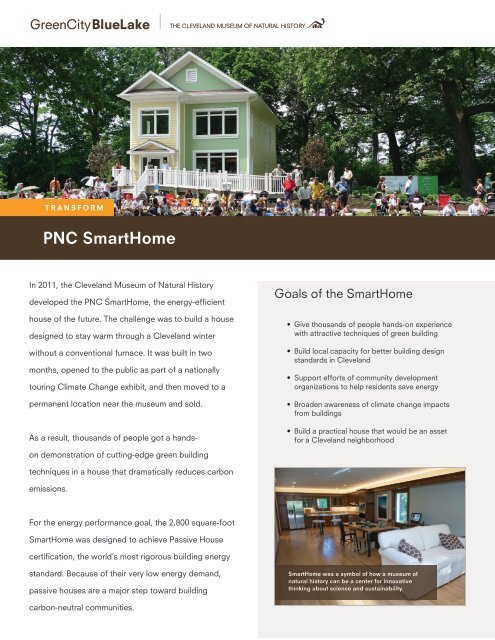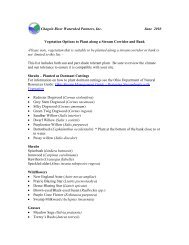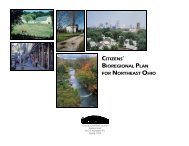SmartHome summary handout - GreenCityBlueLake
SmartHome summary handout - GreenCityBlueLake
SmartHome summary handout - GreenCityBlueLake
You also want an ePaper? Increase the reach of your titles
YUMPU automatically turns print PDFs into web optimized ePapers that Google loves.
THE CLEVELAND MUSEUM OF NATURAL HISTORY<br />
TRANSFORM<br />
PNC <strong>SmartHome</strong><br />
In 2011, the Cleveland Museum of Natural History<br />
developed the PNC <strong>SmartHome</strong>, the energy-efficient<br />
house of the future. The challenge was to build a house<br />
designed to stay warm through a Cleveland winter<br />
without a conventional furnace. It was built in two<br />
months, opened to the public as part of a nationally<br />
touring Climate Change exhibit, and then moved to a<br />
permanent location near the museum and sold.<br />
As a result, thousands of people got a handson<br />
demonstration of cutting-edge green building<br />
Goals of the <strong>SmartHome</strong><br />
• Give thousands of people hands-on experience<br />
with attractive techniques of green building<br />
• Build local capacity for better building design<br />
standards in Cleveland<br />
• Support efforts of community development<br />
organizations to help residents save energy<br />
• Broaden awareness of climate change impacts<br />
from buildings<br />
• Build a practical house that would be an asset<br />
for a Cleveland neighborhood<br />
techniques in a house that dramatically reduces carbon<br />
emissions.<br />
For the energy performance goal, the 2,800 square-foot<br />
<strong>SmartHome</strong> was designed to achieve Passive House<br />
certification, the world’s most rigorous building energy<br />
standard. Because of their very low energy demand,<br />
passive houses are a major step toward building<br />
<strong>SmartHome</strong> was a symbol of how a museum of<br />
natural history can be a center for innovative<br />
thinking about science and sustainability.<br />
carbon-neutral communities.
What is a Passive House<br />
The <strong>SmartHome</strong> followed these design principles which are<br />
common in energy-efficient passive houses:<br />
Thick walls of insulation and air-tight construction<br />
greatly reduce energy demand of the <strong>SmartHome</strong>.<br />
• Heat-retaining building shape: A simple, rectangular<br />
shape minimizes the ratio of surface area to volume.<br />
• Super insulation: Walls are more than a foot thick, and<br />
packed with insulation to achieve R-50.<br />
• High-performance windows: Triple-pane windows<br />
achieve R-11, and close like a bank vault to stop drafts.<br />
• Air-tight construction: All holes and seams in the building<br />
perimeter were carefully sealed to achieve 0.6 air<br />
changes per hour when measured by a blower door test.<br />
• Thermal-bridge free construction: Design and insulation<br />
eliminated heat conduction through the walls.<br />
• Heat-recovery ventilation: The system for bringing<br />
in fresh air warms incoming cold air with the heat of<br />
exhaust air.<br />
• Efficient HVAC: <strong>SmartHome</strong> is designed to maintain<br />
temperatures like a Thermos. Heating demand is so low<br />
that, instead of a furnace, a small, ductless air-source<br />
heat pump provides supplementary heating and cooling.<br />
• Passive solar and shading: Designed for a south-facing<br />
lot to allow sunlight to enter and warm the house during<br />
winter, but shaded during the summer.<br />
• EnergyStar appliances and high efficiency LED lighting.<br />
The results<br />
Triple-pane windows are just starting to catch on<br />
in the U.S. but are a mainstay in Europe where<br />
passive houses number in the tens of thousands.<br />
More information<br />
David Beach, director of the <strong>GreenCityBlueLake</strong><br />
Institute, managed the project for the museum.<br />
For more details, see:<br />
www.gcbl.org/projects/pnc-smarthome<br />
© 2012 The Cleveland Museum of Natural History<br />
• The project involved more than 100 partners including<br />
contractors, suppliers, neighborhood groups, the city of<br />
Cleveland, local artists and real estate professionals.<br />
• The <strong>SmartHome</strong> design-build team conducted technical<br />
workshops for local builders, architects, city officials and<br />
home building industry professionals.<br />
• City residents were invited to free tours and workshops<br />
on home energy savings.<br />
• CMNH staff worked with Enterprise Community Partners<br />
on a tour and discussion with Cleveland neighborhood<br />
groups about energy efficiency and affordable housing.<br />
• Inspired by <strong>SmartHome</strong>, other building projects in<br />
Northeast Ohio are now using passive design principles.<br />
• The <strong>SmartHome</strong> generated national media attention.<br />
• As an exhibit, the <strong>SmartHome</strong> was a hit. Nearly 10,000<br />
museum visitors went on guided tours.<br />
• And it is a permanent investment in Cleveland.<br />
Green City Blue Lake INSTITUTE<br />
1 Wade Oval Dr.<br />
Cleveland, OH 44106<br />
216 231 4600<br />
www.gcbl.org




